[English] 日本語
 Yorodumi
Yorodumi- PDB-6pw8: Hydrocarbon-Stapled Paxillin Peptide Bound to the Focal Adhesion ... -
+ Open data
Open data
- Basic information
Basic information
| Entry | Database: PDB / ID: 6pw8 | |||||||||
|---|---|---|---|---|---|---|---|---|---|---|
| Title | Hydrocarbon-Stapled Paxillin Peptide Bound to the Focal Adhesion Targeting (FAT) Domain of the Focal Adhesion Kinase (FAK) | |||||||||
 Components Components |
| |||||||||
 Keywords Keywords | PROTEIN BINDING/INHIBITOR / Inhibitor / Stapled Peptide / Tyrosine Kinase / PROTEIN BINDING-INHIBITOR complex | |||||||||
| Function / homology |  Function and homology information Function and homology informationnetrin-activated signaling pathway / regulation of substrate adhesion-dependent cell spreading / Regulation of cytoskeletal remodeling and cell spreading by IPP complex components / Localization of the PINCH-ILK-PARVIN complex to focal adhesions / regulation of endothelial cell migration / Regulation of MITF-M-dependent genes involved in extracellular matrix, focal adhesion and epithelial-to-mesenchymal transition / regulation of epithelial cell migration / detection of muscle stretch / neuropilin binding / vinculin binding ...netrin-activated signaling pathway / regulation of substrate adhesion-dependent cell spreading / Regulation of cytoskeletal remodeling and cell spreading by IPP complex components / Localization of the PINCH-ILK-PARVIN complex to focal adhesions / regulation of endothelial cell migration / Regulation of MITF-M-dependent genes involved in extracellular matrix, focal adhesion and epithelial-to-mesenchymal transition / regulation of epithelial cell migration / detection of muscle stretch / neuropilin binding / vinculin binding / JUN kinase binding / signal complex assembly / positive regulation of ubiquitin-dependent protein catabolic process / positive regulation of macrophage proliferation / DCC mediated attractive signaling / Signal regulatory protein family interactions / positive regulation of fibroblast migration / regulation of GTPase activity / microtubule associated complex / MET activates PTK2 signaling / growth hormone receptor signaling pathway / regulation of focal adhesion assembly / negative regulation of cell-cell adhesion / positive regulation of wound healing / p130Cas linkage to MAPK signaling for integrins / Apoptotic cleavage of cellular proteins / regulation of osteoblast differentiation / regulation of cytoskeleton organization / regulation of cell adhesion mediated by integrin / positive regulation of macrophage chemotaxis / Fc-gamma receptor signaling pathway involved in phagocytosis / establishment of cell polarity / regulation of protein phosphorylation / vascular endothelial cell response to oscillatory fluid shear stress / GRB2:SOS provides linkage to MAPK signaling for Integrins / positive regulation of protein kinase activity / negative regulation of anoikis / positive regulation of epithelial cell migration / Estrogen-dependent nuclear events downstream of ESR-membrane signaling / RHO GTPases Activate WASPs and WAVEs / Smooth Muscle Contraction / vascular endothelial growth factor receptor signaling pathway / ephrin receptor signaling pathway / GAB1 signalosome / positive regulation of epithelial to mesenchymal transition / endothelial cell migration / regulation of cell adhesion / heart morphogenesis / PTK6 Regulates RHO GTPases, RAS GTPase and MAP kinases / stress fiber / positive regulation of stress fiber assembly / Integrin signaling / EPHB-mediated forward signaling / NCAM signaling for neurite out-growth / substrate adhesion-dependent cell spreading / transforming growth factor beta receptor signaling pathway / protein tyrosine phosphatase activity / axon guidance / SH2 domain binding / molecular function activator activity / peptidyl-tyrosine phosphorylation / placenta development / Turbulent (oscillatory, disturbed) flow shear stress activates signaling by PIEZO1 and integrins in endothelial cells / integrin-mediated signaling pathway / non-membrane spanning protein tyrosine kinase activity / cellular response to reactive oxygen species / FCGR3A-mediated phagocytosis / non-specific protein-tyrosine kinase / cell motility / beta-catenin binding / Regulation of actin dynamics for phagocytic cup formation / VEGFA-VEGFR2 Pathway / integrin binding / epidermal growth factor receptor signaling pathway / positive regulation of protein phosphorylation / cell-cell junction / cell migration / regulation of cell shape / lamellipodium / regulation of cell population proliferation / protein autophosphorylation / actin binding / RAF/MAP kinase cascade / protein tyrosine kinase activity / angiogenesis / cell cortex / protein phosphatase binding / cytoskeleton / Extra-nuclear estrogen signaling / positive regulation of phosphatidylinositol 3-kinase/protein kinase B signal transduction / cell adhesion / cilium / positive regulation of cell migration / ciliary basal body / focal adhesion / intracellular membrane-bounded organelle / positive regulation of cell population proliferation / centrosome / protein kinase binding / negative regulation of apoptotic process Similarity search - Function | |||||||||
| Biological species |  Homo sapiens (human) Homo sapiens (human) | |||||||||
| Method |  X-RAY DIFFRACTION / X-RAY DIFFRACTION /  SYNCHROTRON / SYNCHROTRON /  MOLECULAR REPLACEMENT / Resolution: 1.95 Å MOLECULAR REPLACEMENT / Resolution: 1.95 Å | |||||||||
 Authors Authors | Thifault, D.G. / Fromme, P. / Martin-Garcia, J.M. | |||||||||
 Citation Citation |  Journal: To Be Published Journal: To Be PublishedTitle: Stapled Peptide Ligand Bound to the Focal Adhesion Targeting (FAT) Domain of the Focal Adhesion Kinase (FAK) Authors: Thifault, D.G. / Fromme, P. / Martin-Garcia, J.M. #1: Journal: Acta Crystallogr.,Sect.D / Year: 2012 Title: Towards automated crystallographic structure refinement with phenix.refine. Authors: Afonine, P.V. / Grosse-Kunstleve, R.W. / Echols, N. / Headd, J.J. / Moriarty, N.W. / Mustyakimov, M. / Terwilliger, T.C. / Urzhumtsev, A. / Zwart, P.H. / Adams, P.D. #2: Journal: Acta Crystallogr D Biol Crystallogr / Year: 2010 Title: PHENIX: a comprehensive Python-based system for macromolecular structure solution. Authors: Paul D Adams / Pavel V Afonine / Gábor Bunkóczi / Vincent B Chen / Ian W Davis / Nathaniel Echols / Jeffrey J Headd / Li-Wei Hung / Gary J Kapral / Ralf W Grosse-Kunstleve / Airlie J McCoy ...Authors: Paul D Adams / Pavel V Afonine / Gábor Bunkóczi / Vincent B Chen / Ian W Davis / Nathaniel Echols / Jeffrey J Headd / Li-Wei Hung / Gary J Kapral / Ralf W Grosse-Kunstleve / Airlie J McCoy / Nigel W Moriarty / Robert Oeffner / Randy J Read / David C Richardson / Jane S Richardson / Thomas C Terwilliger / Peter H Zwart /  Abstract: Macromolecular X-ray crystallography is routinely applied to understand biological processes at a molecular level. However, significant time and effort are still required to solve and complete many ...Macromolecular X-ray crystallography is routinely applied to understand biological processes at a molecular level. However, significant time and effort are still required to solve and complete many of these structures because of the need for manual interpretation of complex numerical data using many software packages and the repeated use of interactive three-dimensional graphics. PHENIX has been developed to provide a comprehensive system for macromolecular crystallographic structure solution with an emphasis on the automation of all procedures. This has relied on the development of algorithms that minimize or eliminate subjective input, the development of algorithms that automate procedures that are traditionally performed by hand and, finally, the development of a framework that allows a tight integration between the algorithms. | |||||||||
| History |
|
- Structure visualization
Structure visualization
| Structure viewer | Molecule:  Molmil Molmil Jmol/JSmol Jmol/JSmol |
|---|
- Downloads & links
Downloads & links
- Download
Download
| PDBx/mmCIF format |  6pw8.cif.gz 6pw8.cif.gz | 47 KB | Display |  PDBx/mmCIF format PDBx/mmCIF format |
|---|---|---|---|---|
| PDB format |  pdb6pw8.ent.gz pdb6pw8.ent.gz | 29.2 KB | Display |  PDB format PDB format |
| PDBx/mmJSON format |  6pw8.json.gz 6pw8.json.gz | Tree view |  PDBx/mmJSON format PDBx/mmJSON format | |
| Others |  Other downloads Other downloads |
-Validation report
| Summary document |  6pw8_validation.pdf.gz 6pw8_validation.pdf.gz | 439.5 KB | Display |  wwPDB validaton report wwPDB validaton report |
|---|---|---|---|---|
| Full document |  6pw8_full_validation.pdf.gz 6pw8_full_validation.pdf.gz | 439.9 KB | Display | |
| Data in XML |  6pw8_validation.xml.gz 6pw8_validation.xml.gz | 8.9 KB | Display | |
| Data in CIF |  6pw8_validation.cif.gz 6pw8_validation.cif.gz | 11.4 KB | Display | |
| Arichive directory |  https://data.pdbj.org/pub/pdb/validation_reports/pw/6pw8 https://data.pdbj.org/pub/pdb/validation_reports/pw/6pw8 ftp://data.pdbj.org/pub/pdb/validation_reports/pw/6pw8 ftp://data.pdbj.org/pub/pdb/validation_reports/pw/6pw8 | HTTPS FTP |
-Related structure data
| Related structure data |  1k05S S: Starting model for refinement |
|---|---|
| Similar structure data |
- Links
Links
- Assembly
Assembly
| Deposited unit | 
| ||||||||||||
|---|---|---|---|---|---|---|---|---|---|---|---|---|---|
| 1 |
| ||||||||||||
| Unit cell |
|
- Components
Components
| #1: Protein | Mass: 14018.440 Da / Num. of mol.: 1 Fragment: focal adhesion targeting domain (UNP residues 749-874) Source method: isolated from a genetically manipulated source Source: (gene. exp.)  Homo sapiens (human) / Gene: PTK2, FAK, FAK1 / Production host: Homo sapiens (human) / Gene: PTK2, FAK, FAK1 / Production host:  References: UniProt: Q05397, non-specific protein-tyrosine kinase |
|---|---|
| #2: Protein/peptide | Mass: 1660.996 Da / Num. of mol.: 1 / Source method: obtained synthetically / Source: (synth.)  Homo sapiens (human) / References: UniProt: P49023*PLUS Homo sapiens (human) / References: UniProt: P49023*PLUS |
| #3: Chemical | ChemComp-ZN / |
| #4: Chemical | ChemComp-CL / |
| #5: Water | ChemComp-HOH / |
| Has ligand of interest | Y |
-Experimental details
-Experiment
| Experiment | Method:  X-RAY DIFFRACTION / Number of used crystals: 1 X-RAY DIFFRACTION / Number of used crystals: 1 |
|---|
- Sample preparation
Sample preparation
| Crystal | Density Matthews: 2.15 Å3/Da / Density % sol: 42.85 % |
|---|---|
| Crystal grow | Temperature: 293 K / Method: vapor diffusion, hanging drop / Details: 0.02 M zinc chloride, 20% PEG3350 |
-Data collection
| Diffraction | Mean temperature: 293 K / Serial crystal experiment: N |
|---|---|
| Diffraction source | Source:  SYNCHROTRON / Site: SYNCHROTRON / Site:  APS APS  / Beamline: 23-ID-D / Wavelength: 1.02 Å / Beamline: 23-ID-D / Wavelength: 1.02 Å |
| Detector | Type: DECTRIS PILATUS3 6M / Detector: PIXEL / Date: Apr 21, 2019 / Details: K-B Pair Bimorph Mirrors |
| Radiation | Monochromator: Si(111) / Protocol: SINGLE WAVELENGTH / Monochromatic (M) / Laue (L): M / Scattering type: x-ray |
| Radiation wavelength | Wavelength: 1.02 Å / Relative weight: 1 |
| Reflection | Resolution: 1.95→47.49 Å / Num. obs: 10290 / % possible obs: 99.7 % / Redundancy: 2 % / Biso Wilson estimate: 33.57 Å2 / Rmerge(I) obs: 0.114 / Net I/σ(I): 12.8 |
| Reflection shell | Resolution: 1.95→2.02 Å / Rmerge(I) obs: 1.859 / Num. unique obs: 1014 / % possible all: 99.5 |
- Processing
Processing
| Software |
| |||||||||||||||||||||||||||||||||||
|---|---|---|---|---|---|---|---|---|---|---|---|---|---|---|---|---|---|---|---|---|---|---|---|---|---|---|---|---|---|---|---|---|---|---|---|---|
| Refinement | Method to determine structure:  MOLECULAR REPLACEMENT MOLECULAR REPLACEMENTStarting model: PDB entry 1K05 Resolution: 1.95→37.66 Å / SU ML: 0.2365 / Cross valid method: THROUGHOUT / σ(F): 1.35 / Phase error: 29.0201 / Stereochemistry target values: CDL v1.2
| |||||||||||||||||||||||||||||||||||
| Solvent computation | Shrinkage radii: 0.9 Å / VDW probe radii: 1.11 Å / Solvent model: FLAT BULK SOLVENT MODEL | |||||||||||||||||||||||||||||||||||
| Displacement parameters | Biso mean: 38.06 Å2 | |||||||||||||||||||||||||||||||||||
| Refinement step | Cycle: LAST / Resolution: 1.95→37.66 Å
| |||||||||||||||||||||||||||||||||||
| Refine LS restraints |
| |||||||||||||||||||||||||||||||||||
| LS refinement shell |
|
 Movie
Movie Controller
Controller


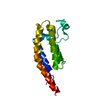
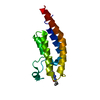
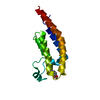
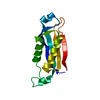
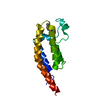


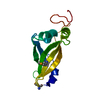
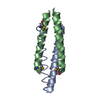
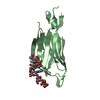
 PDBj
PDBj



















